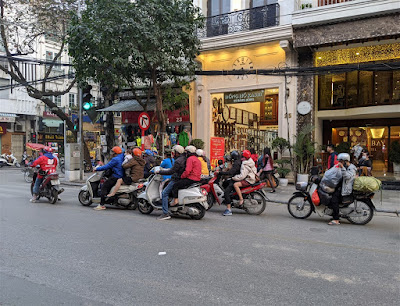All the guidebooks warn you, but you have to experience the motorbike thing to understand, especially in the old city, with its density, narrow streets and alleys. Our hotel had a very useful information sheet for tourists (and in English too), the first item of which was "how to cross a street in Hanoi." Paraphrasing a bit, it said "appear confident and determined, look both ways, proceed when there is an opening, try to cross with a group, do
not back up or return to the curb." There are occasional cross-walks and occasional cross-walk lights, which occasionally work. Many of the streets are one-way, but some motos do not appear to be bound by such rules. Also traffic lights. Many motos freely make right-hand turns on red, or left-hand turns on red, often without stopping or looking. The traffic light T-shirt pictured below captures much of this. All part of the experience, I guess. I count it our best experience in Hanoi not to have been injured. And we've consistently heard that HCMC is much worse. Something to look forward to.
 |
| On Hang Bong Street, our home |
 |
Unusual child-seating; usually the toddler is just squeezed in at the handlebar,
between the driver's legs |
 |
| Massing for attack |
 |
The old city has sidewalks, but they are used primarily for
motorbike parking or restaurant seating or shop-keeping or
most anything but pedestrians; most of your walking is in
the street; shared use |



























































